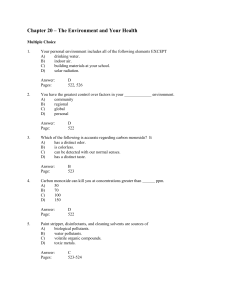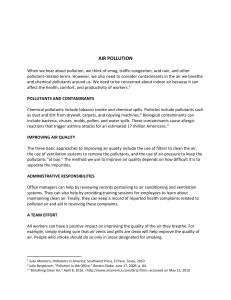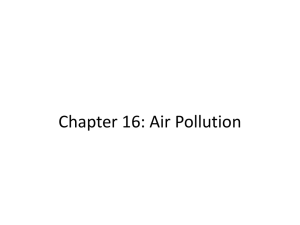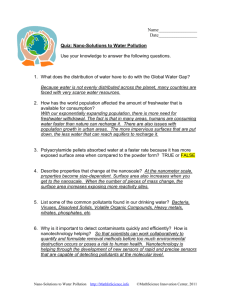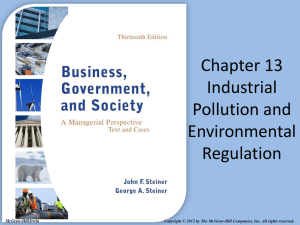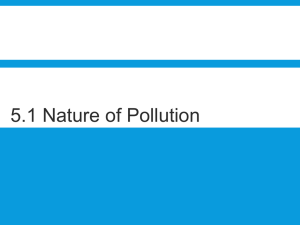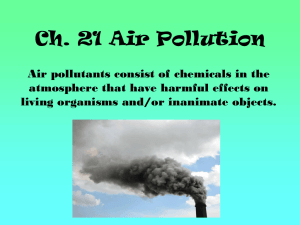Environmental Health Test Questions
advertisement
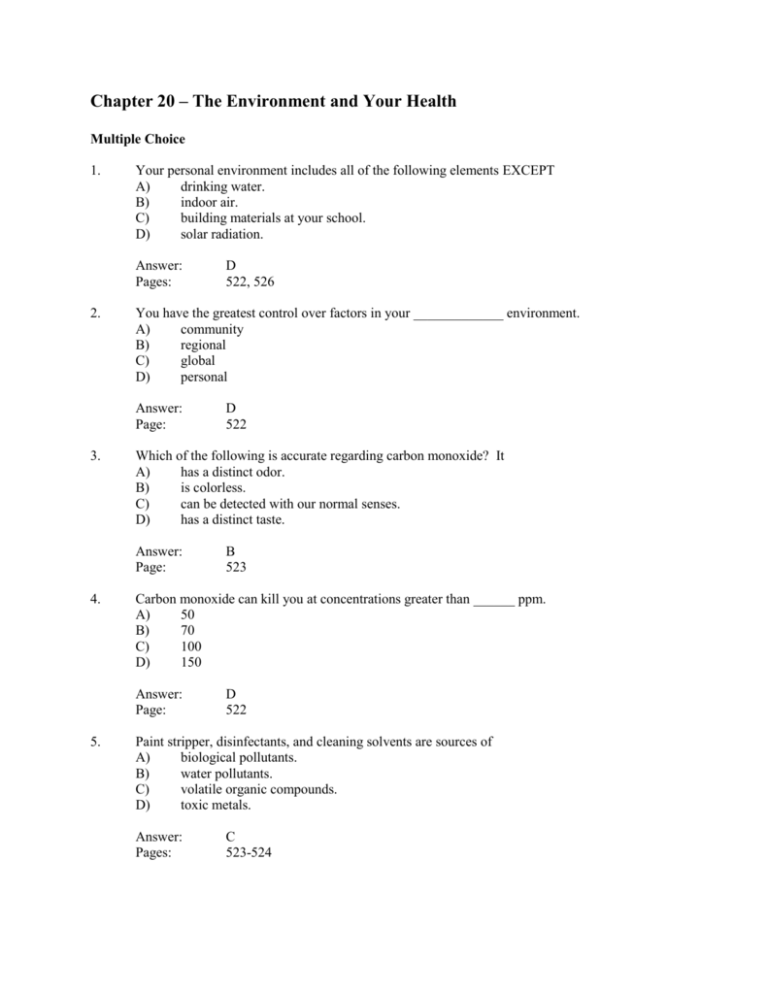
Chapter 20 – The Environment and Your Health Multiple Choice 1. Your personal environment includes all of the following elements EXCEPT A) drinking water. B) indoor air. C) building materials at your school. D) solar radiation. Answer: Pages: 2. You have the greatest control over factors in your _____________ environment. A) community B) regional C) global D) personal Answer: Page: 3. B 523 Carbon monoxide can kill you at concentrations greater than ______ ppm. A) 50 B) 70 C) 100 D) 150 Answer: Page: 5. D 522 Which of the following is accurate regarding carbon monoxide? It A) has a distinct odor. B) is colorless. C) can be detected with our normal senses. D) has a distinct taste. Answer: Page: 4. D 522, 526 D 522 Paint stripper, disinfectants, and cleaning solvents are sources of A) biological pollutants. B) water pollutants. C) volatile organic compounds. D) toxic metals. Answer: Pages: C 523-524 6. Long term exposure to volatile organic compounds such as paint and cleaning solvents are likely to do all of the following EXCEPT damage the A) liver. B) kidney. C) skeletal system. D) nervous system. Answer: Page: 7. Which of the following scenarios would MOST likely expose someone to asbestos? A) putting insulation into a new building B) knocking down walls and ceilings in an older building C) installing a wood floor over cement in an old building’s basement D) putting new shingles over old shingles Answer: Page: 8. B 524-525 Most documented health effects of non-ionizing radiation are associated with A) DNA damage in brain cells B) heating of body tissues resulting in sunburn C) certain cancers D) dizziness, shortness of breath, and headache Answer: Page: 11. A 524 All of the following are sources of biological air pollutants EXCEPT A) coughs or sneezes by infected humans. B) nitrate from agricultural runoff. C) mold growing on moist surfaces. D) poorly maintained ventilation systems. Answer: Pages: 10. B 524 Lead has the most serious health effects for which group? A) infants and children B) adolescents and young adults C) adults D) older adults Answer: Page: 9. C 524 B 525 The U.S. Surgeon General has warned that exposure to radon gas is the _________ leading cause of lung cancer in the United States. A) first B) second C) third D) fourth Answer: Page: 12. If unsafe levels of radon are detected in your home, you should A) ignore the problem. B) work with a certified radon reduction contractor. C) sell your home. D) address the high levels yourself. Answer: Page: 13. A 526 Daily exposure to music at _____ decibels will cause permanent hearing loss. A) 80 to 100 B) 75 to 85 C) 90 to 100 D) 110 to 120 Answer: Page: 16. C 526 Private water supplies should be tested annually for A) fecal coliform bacteria. B) carbon monoxide. C) sulfur dioxide. D) radioactive contamination. Answer: Page: 15. B 525 About ____________ people in the United States obtain their drinking water from groundwater sources such as wells, streams, or cisterns. A) 350,000 B) 700,000 C) 23 million D) 30 million Answer: Page: 14. B 525 D 527 All of the following are threats to the regional environment EXCEPT A) loss of rainforests. B) loss of green spaces. C) industrial development. D) septic systems. Answer: Pages: A 528, 536 17. Sarah is frustrated about the issues regarding her community environmental conditions. Which of the following actions is recommend within the text and is indicated to have a significant impact on the community environmental problems? A) going door to door and complaining to the local neighbors B) writing a letter to your local mayor C) joining an organization whose focus is improving the environment D) starting your own environmental group Answer: Page: 18. Electric power stations, industrial facilities, and chemical factories are classified as ________ sources. A) nonpoint B) point C) electric D) energy Answer: Page: 19. B 530 ______________ are a diverse collection of hazardous air pollutants produced mainly by electric power plants, industrial sources, and internal combustion engines that constitute a widespread environmental health risk in the United States. A) Environmental toxics B) Air toxics C) Environmental contaminants D) Air contaminants Answer: Page: 21. B 528 The brownish haze over communities where substances produced when hydrocarbons, nitrogen oxides, and other small particulate matter chemically interact in the presence of sunlight is referred to as A) haze matter. B) smog. C) precipitation. D) clouds. Answer: Page: 20. C 528 B 530 The largest sources of biological water pollutants in surface waters of the United States today is from A) acid rain. B) car pollution. C) overflowing septic and storm sewers. D) landfill runoff. Answer: C Page: 22. Pregnant women should be especially careful of consuming shellfish, fish, or wild game because of which two contaminants? A) mercury and folate B) mercury and PCBs C) iodine and PCBs D) iodine and fluorine Answer: Page: 23. C 535 Exposure to ionizing radiation can cause all of the following EXCEPT A) hair loss. B) death. C) bleeding from the mouth. D) weight gain. Answer: Page: 26. A 533 The hidden dark side of the technology evolution with respect to the environment is the increased A) amount of paper usage. B) electricity utilized. C) accumulation of obsolete electronic equipment. D) stay-at-home workers. Answer: Page: 25. B 532 Most land pollution today is associated with the disposal of ________________ waste. A) solid B) biochemical C) animal D) biohazardous Answer: Page: 24. 531 D 535 There are currently more than __________ people in the global population. A) 900 million B) 2 billion C) 6 billion D) 10 billion Answer: Page: C 536 27. Which of the following is NOT one of the major concerns about the expansion of the human population? A) the gradual depletion of natural resources B) an increase in air and water pollution C) a decrease in conflict and political upheaval D) an increase in starvation Answer: Pages: 28. Each year, approximately _____ million children die from waterborne diarrhea diseases associated win unsanitary drinking water. A) 1 B) 2 C) 3 D) 5 Answer: Page: 29. B 537 Most of the increase in atmospheric carbon dioxide is associated with burning A) fossil fuel. B) wood and foliage. C) plastic containers. D) tires. Answer: Page: 31. D 536 Providing education opportunities to girls can have major and long lasting effects that act to reduce population growth. Educated women have ________ number of pregnancies as compared to their uneducated sisters. A) the same B) half the C) one third the D) one fourth the Answer: Page: 30. C 536 A 537 The effects of global warming can include A) increased length of life. B) greater loss of life in storms and floods. C) increased food availability. D) increase in varieties of animal species. Answer: Page: B 538 32. Ecological effects of global warming include all of the following EXCEPT an increase in A) frequency of wildfires. B) insect pest outbreaks. C) coral reef growth. D) water temperatures. Answer: Page: 33. The primary way of reducing and reversing global warming associated with human activities is to reduce the A) total amount of livestock that releases methane gases. B) amount of aerosol products we currently use. C) number of landfills and garbage dumps. D) burning of fossil fuels. Answer: Page: 34. A 538 Which of the following is thought to contribute to ozone depletion? A) chlorofluorocarbons B) carbon dioxide C) nitrates D) biological pollutants Answer: Pages: 36. D 537 Individually, you can reduce your personal contribution to global warming by doing all of these EXCEPT A) purchasing appliances without an energy efficiency rating. B) conserving electricity at home. C) driving the most fuel-efficient automobile. D) using mass transit where available. Answer: Page: 35. C 538 A 539-540 The cumulative effects of all the human-caused changes to Earth’s land and oceans have increased the species extinction rate by A) 5-100 times. B) 100-1,000 times. C) 500-2,000 times. D) 1,000-3,000 times. Answer: Page: B 541 37. The theory that human evolution predisposes us to desire green spaces and diverse biological systems is called A) conservationism. B) ecology. C) the biophilia hypothesis. D) the Sierra theory. Answer: Page: C 541 True/False 38. Indoor air is not considered a factor in our environment. Answer: Page: 39. If an environmental factor is damaging to us, we will always feel it right away. Answer: Page: 40. True 524 Radon gas can be detected by its odor before it reaches dangerous levels. Answer: Page: 45. False 524 If they are left undisturbed, asbestos-containing building materials are relatively safe. Answer: Page: 44. False 523 There is no evidence linking tobacco smoke and asthma. Answer: Page: 43. True 524 A smoke detector is sufficient for warning of dangerous levels of carbon monoxide. Answer: Page: 42. False 522 A blood lead level as low as 10 micrograms per deciliter can lower the IQ of a child. Answer: Page: 41. False 522 False 525 Lead-based house paint has been banned from use. Answer: True Page: 46. Because lead-based paint is now banned, it no longer presents a health threat to humans. Answer: Page: 47. Page: False 528 Tropospheric ozone is an air pollutant that results in a brownish haze (also called smog). Answer: Page: 54. False 528 The primary sources of human-caused air pollutants come from the everyday use of aerosol cans and cleaning detergents. Answer: 53. True 527 Air pollution is defined as substances produced by human activities, but not naturally occurring substances. Answer: Page: 52. True 527 Daily exposure to loud music at 110 to 120 decibels will cause permanent hearing loss. Answer: Page: 51. False 526 Excessively loud noise can physically damage the ears. Answer: Page: 50. False 526 There is very little the individual homeowner can do to reduce his contribution to community and regional water pollution. Answer: Page: 49. False 524 Once the water supply enters one’s home, the risk of contamination has ended. Answer: Page: 48. 524 True 530 Weather conditions can have a strong influence on air pollution levels. Answer: Page: True 530 55. A large source of biological water pollutants is the overflow from old septic sewers. Answer: Page: 56. The public health departments monitor local surface waters for the presence of fecal coliform bacteria in every county of the United States. Answer: Page: 57. False 535 Exposure to lower levels of nuclear reactions presents little health risk to the individual. Answer: Page: 63. False 535 Non-ionizing radiation is produced by nuclear reactions and can cause damage to the DNA structure. Answer: Page: 62. False 533 The United States led the initiative to ban the practice of shipping toxic computer waste to underdeveloped countries. Answer: Page: 61. True 532 Most land pollution today is associated with the disposal of hazardous waste. Answer: Page: 60. False 532 To reduce health risks associated with consuming high levels of mercury and PCBs, individuals should monitor their intake of shellfish, fish, and wild game. Answer: Page: 59. True 532 Very few chemicals and pesticides have adverse consequences for natural systems. Answer: Pages: 58. True 531 False 535 Every year, five million children die from waterborne diarrhea diseases associated with unsanitary drinking water. Answer: Page: True 536 64. The rate of population growth can be slowed simply by providing education opportunities to girls. Answer: Page: 65. True 537 The vast majority of the depletion of the ozone layer has occurred near the equator. Answer: Pages: False 537-538 Essay 66. Describe some of the ways you can reduce threats to your health in your personal environment. Answer: Avoid smoking or being around people who smoke; test your home for radon gas; avoid toxic products; check for the threat of asbestos-containing or lead-containing building materials; assess the level of noise pollution at your home, school, and workplace. Page: 67. 523 Discuss the hazards of endocrine disrupting chemicals. What are some common sources of these chemicals? Ans: Endocrine disrupting chemicals are a large class of substances that can interact with the system of glands, hormones, and tissues that regulate many physiological processes in humans, including growth, development from fetus to adult, regulation of metabolic rate and blood sugar, function of reproductive systems, and development of the brain and nervous system. They include a large number of pesticides, herbicides, antiseptics, and chemicals used in the manufacture of plastics. They enter the home and work environment as contaminants of air, food and water in household plastics, non-stick cookware, and in a range of personal products such as cosmetics, hair spray, perfumes, soap, and shampoo. Page: 68. 526-527 Discuss ways that you can limit your own contribution to air pollution. Answer: Buy or rent a vehicle that is no larger than you need to meet your needs; keep your vehicle tuned up; use mass transit, commute by bicycle, or work from home whenever possible; avoid the use of internal-combustion engines for entertainment (e.g., powerboats, motorbikes, all-terrain vehicles); conserve electricity in your home to reduce the demand on electric power plants; quit smoking. Fill your gas tank, mow your lawn, and use your grill during cooler evening hours. Page: 69. 530-531 How can one individual have an effect on the global environment? Answer: One person can have an effect by taking action at a personal level; join political and environmental organizations that protect the environment and give them your time, effort, and financial support; recycle whenever possible; if your community has no recycling program, lobby to start one; avoid patronizing businesses and corporations that damage the global environment; support efforts to slow the global population growth rate. Pages: 70. 541-543 Discuss how the increase in human population has affected natural habitats and the rate of species’ extinction. Answer: Due to an exploding human population, humans have now altered or taken over the habitats of other species on the planet. As much as 40 to 50 percent of the land surface has been transformed or degraded by human activities. The earth has lost almost half of its original forest cover and only 20 percent of the original rain forest cover on earth remains ecologically intact and able to support all its species. The current human population uses 50 percent of the earth’s fresh water runoff and 70 percent of that is used for agriculture irrigation. Twenty-two percent of the ocean fisheries are considered overexploited and many of the wetlands, mangrove forests, and coral reefs have been destroyed or degraded due to human activity. Pages: 540-543
